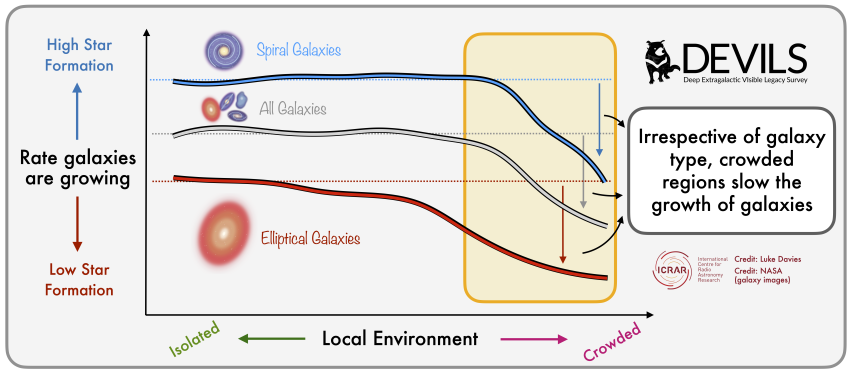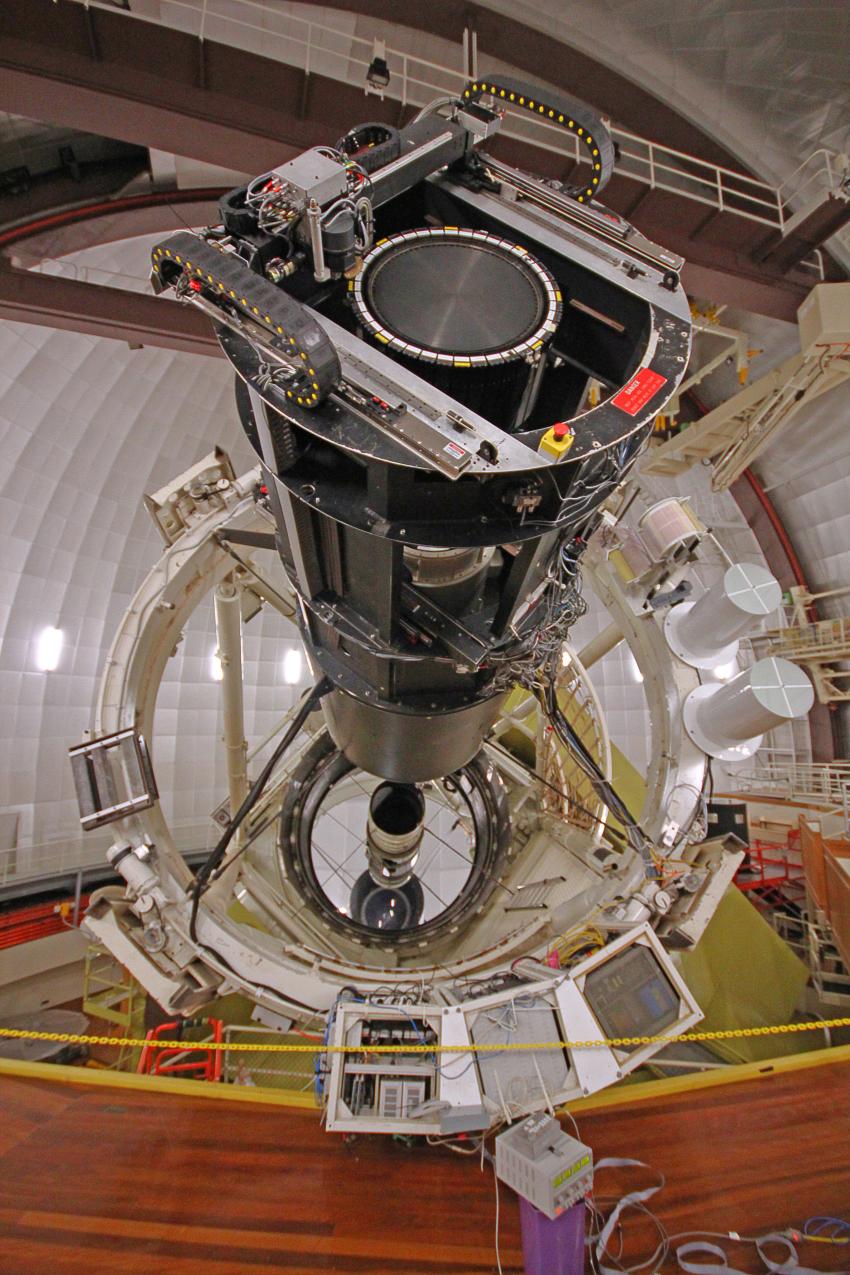A galaxy's local neighbourhood – or where it 'lives' – plays a major role in how its shape, size and growth rate changes over time, according to a new, first of its kind survey of the cosmos.
The Deep Extragalactic Visible Legacy Survey, or DEVILS for short, has released its initial data, published today in Monthly Notices of the Royal Astronomical Society.
It explores how a galaxy's location in the universe can significantly influence its evolution.
Project lead Associate Professor Luke Davies, of The University of Western Australia node of the International Centre for Radio Astronomy Research (ICRAR), said the work represented the culmination of a decade's worth of planning, observations and data analysis – offering a new level of detail in our understanding of galaxies in the distant universe.
The DEVILS survey is unique in that it is the first of its kind to explore the detailed aspects of the distant universe. It focuses on galaxies that existed up to five billion years ago, and examines how these galaxies have changed to the present day.
"While previous surveys during this period of universal history have explored the broad evolution of galaxy properties, they have inherently lacked the capacity to determine the finer details of the cosmic landscape," A/Professor Davies said.
"In the DEVILS survey, we have been able to zoom in and focus on mapping out the small-scale environment of galaxies – such as mountains, hills, valleys and plateaus as compared to large-scale environments such as oceans or continents."
From this new approach, A/Professor Davies and his team have found that where a galaxy lives strongly influences its shape, size and growth rate in the distant universe.
This data will allow researchers to identify the number of stars in a galaxy, understand ongoing star formation, and analyse their visual appearance, shapes and structures. They can then compare these properties between galaxies in the present day universe to galaxies that existed around five billion years ago and determine how galaxies are changing in time.
"Our upbringing and environment influence who we are," A/Professor Davies added. "Someone who has lived their whole life in the city may have a very different personality compared to someone who lives remotely or in an isolated community. Galaxies are no different."
The team found that where a galaxy lived had a strong impact on many aspects of its lifecycle.
“Galaxies that are surrounded by lots of other galaxies – the bustling city centres of the cosmos – tend to grow more slowly and have very different structures compared to their isolated counterparts,” A/Professor Davies said.
In crowded regions of the universe, galaxies interact with each other and compete for resources such as gas to form stars and grow. This competition can impact their evolution and, in some instances, cause star formation to slow down earlier than expected – causing galaxies to die.
The DEVILS data continues to be utilised, and with this public release, the team expects other researchers to leverage the data for their own innovative research.
A/Professor Davies’ team is now looking to expand the DEVILS survey.
"DEVILS forms the basis of our future plans in exploring this key area of astrophysics research," he said.
"DEVILS has given us a detailed picture of galaxy evolution and next year, we will start collecting data for WAVES (Wide Area VISTA Extragalactic Survey). WAVES will allow us to significantly expand the number of galaxies and environments we study, plus help us build an even clearer picture of how the universe came to look the way it does today."
ENDS
Media contacts
Sam Tonkin
Royal Astronomical Society
Mob: +44 (0)7802 877 700
Dr Robert Massey
Royal Astronomical Society
Mob: +44 (0)7802 877 699
Science contacts
Associate Professor Luke Davies
The University of Western Australia
Images & video
Caption: The region of sky studied in the DEVILS survey
Credit: The DEVILS team
Caption: The rate at which galaxies are growing is slower in crowded environments.
Credit: L. Davies
Caption: The Anglo-Australian Telescope (AAT) where the main component of DEVILS data was collected.
Credit: Ángel López- Sánchez, Macquarie University
Caption: Members of the UWA-based DEVILS Survey team (L to R: Prof. Simon Driver, Melissa Fuentealba Fuentes, Jordan d’Silva, Prof Aaron Robotham, A/Prof Luke Davies, Dr Sabine Bellestedt.
Credit: ICRAR
Further information
The paper 'Deep Extragalactic VIsible Legacy Survey (DEVILS): first data release covering the D10 (COSMOS) region' by Luke Davies et al. has been published in Monthly Notices of the Royal Astronomical Society. DOI: 10.1093/mnras/staf1763
About ICRAR
The International Centre for Radio Astronomy Research (ICRAR) plays a major role in radio astronomy, contributing to scientific discovery, engineering development, education and public engagement. It is a multi-skilled institute of astronomers, engineers, and data specialists working with industry partners throughout Australia, Europe, and the world to support the construction of the SKA telescopes in Australia and South Africa and expand our understanding of the Universe.
It is a joint venture between Curtin University and The University of Western Australia, with support and funding from the State Government of Western Australia.
Notes for editors
About the Royal Astronomical Society
The Royal Astronomical Society (RAS), founded in 1820, encourages and promotes the study of astronomy, solar-system science, geophysics and closely related branches of science.
The RAS organises scientific meetings, publishes international research and review journals, recognises outstanding achievements by the award of medals and prizes, maintains an extensive library, supports education through grants and outreach activities and represents UK astronomy nationally and internationally. Its more than 4,000 members (Fellows), a third based overseas, include scientific researchers in universities, observatories and laboratories as well as historians of astronomy and others.
The RAS accepts papers for its journals based on the principle of peer review, in which fellow experts on the editorial boards accept the paper as worth considering. The Society issues press releases based on a similar principle, but the organisations and scientists concerned have overall responsibility for their content.
Keep up with the RAS on Instagram, Bluesky, LinkedIn, Facebook and YouTube.





